A2 Milk Company: Business Scope, Products, and Financial Performance
VerifiedAdded on 2023/01/17
|10
|2426
|46
AI Summary
This article discusses the business scope, major products, and financial performance of the A2 Milk Company. It explores their mission, history, ownership, and size. It also includes a PESTEL analysis and Porter's five forces analysis to determine their competitive edge.
Contribute Materials
Your contribution can guide someone’s learning journey. Share your
documents today.
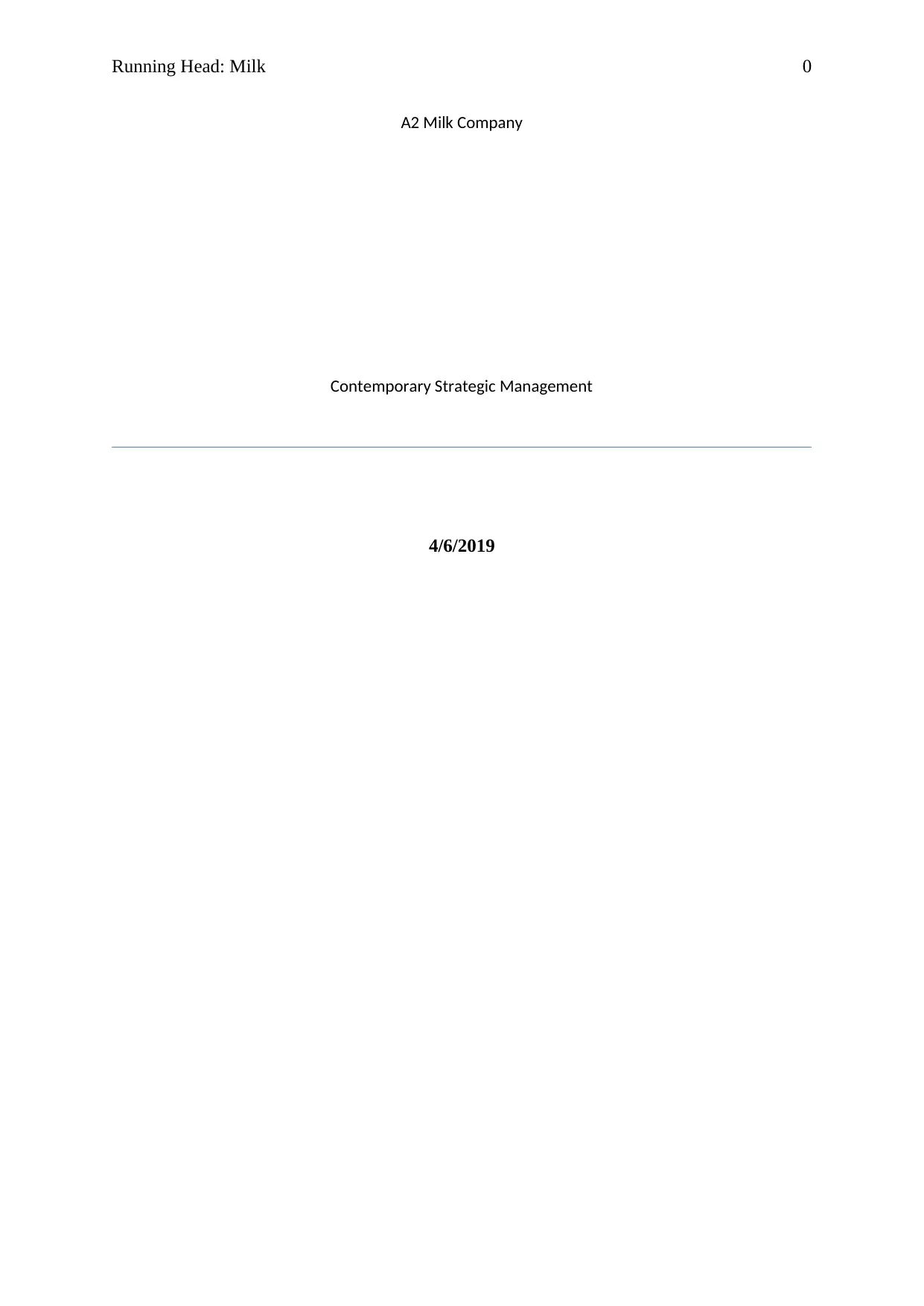
Running Head: Milk 0
A2 Milk Company
Contemporary Strategic Management
4/6/2019
A2 Milk Company
Contemporary Strategic Management
4/6/2019
Secure Best Marks with AI Grader
Need help grading? Try our AI Grader for instant feedback on your assignments.
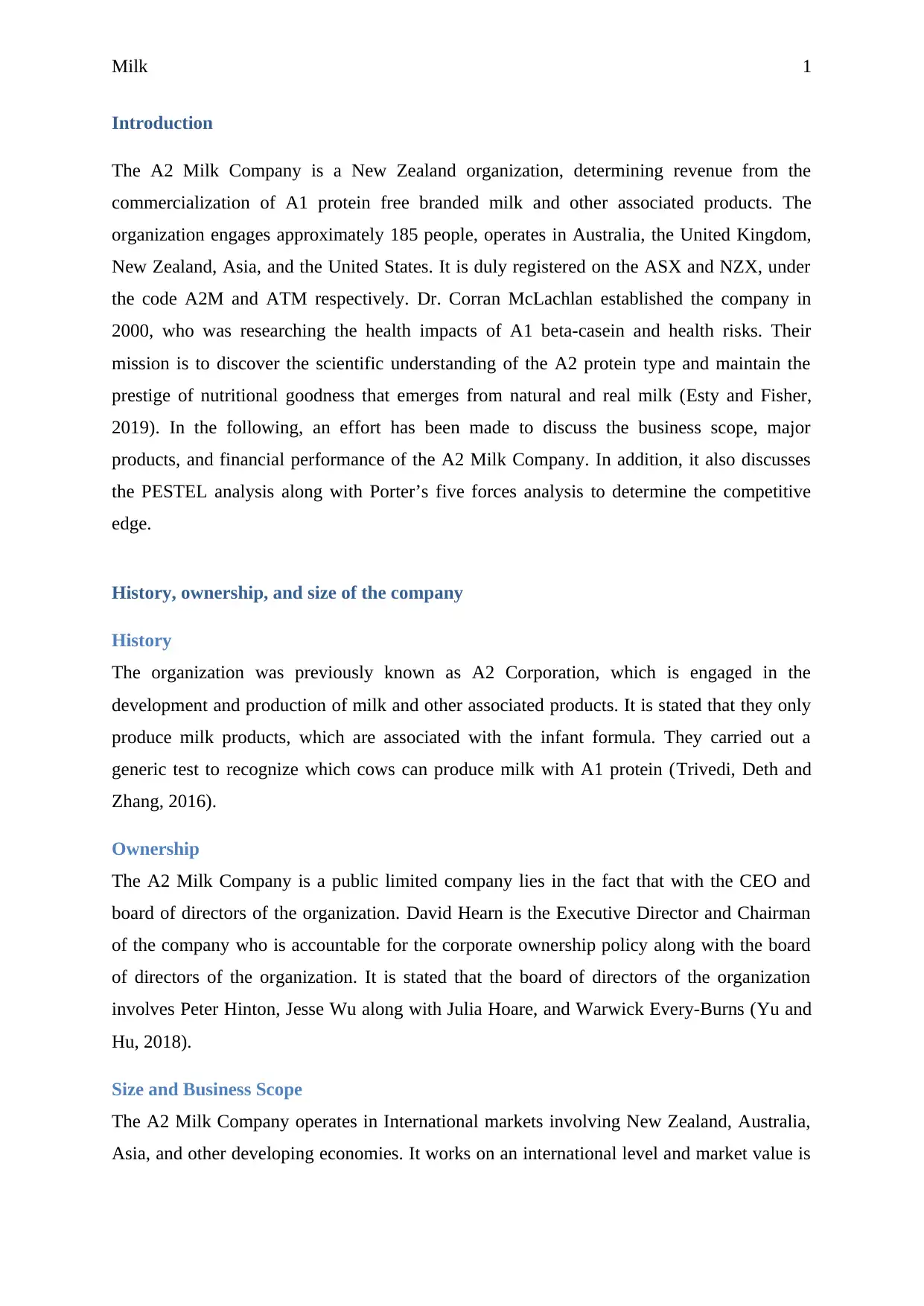
Milk 1
Introduction
The A2 Milk Company is a New Zealand organization, determining revenue from the
commercialization of A1 protein free branded milk and other associated products. The
organization engages approximately 185 people, operates in Australia, the United Kingdom,
New Zealand, Asia, and the United States. It is duly registered on the ASX and NZX, under
the code A2M and ATM respectively. Dr. Corran McLachlan established the company in
2000, who was researching the health impacts of A1 beta-casein and health risks. Their
mission is to discover the scientific understanding of the A2 protein type and maintain the
prestige of nutritional goodness that emerges from natural and real milk (Esty and Fisher,
2019). In the following, an effort has been made to discuss the business scope, major
products, and financial performance of the A2 Milk Company. In addition, it also discusses
the PESTEL analysis along with Porter’s five forces analysis to determine the competitive
edge.
History, ownership, and size of the company
History
The organization was previously known as A2 Corporation, which is engaged in the
development and production of milk and other associated products. It is stated that they only
produce milk products, which are associated with the infant formula. They carried out a
generic test to recognize which cows can produce milk with A1 protein (Trivedi, Deth and
Zhang, 2016).
Ownership
The A2 Milk Company is a public limited company lies in the fact that with the CEO and
board of directors of the organization. David Hearn is the Executive Director and Chairman
of the company who is accountable for the corporate ownership policy along with the board
of directors of the organization. It is stated that the board of directors of the organization
involves Peter Hinton, Jesse Wu along with Julia Hoare, and Warwick Every-Burns (Yu and
Hu, 2018).
Size and Business Scope
The A2 Milk Company operates in International markets involving New Zealand, Australia,
Asia, and other developing economies. It works on an international level and market value is
Introduction
The A2 Milk Company is a New Zealand organization, determining revenue from the
commercialization of A1 protein free branded milk and other associated products. The
organization engages approximately 185 people, operates in Australia, the United Kingdom,
New Zealand, Asia, and the United States. It is duly registered on the ASX and NZX, under
the code A2M and ATM respectively. Dr. Corran McLachlan established the company in
2000, who was researching the health impacts of A1 beta-casein and health risks. Their
mission is to discover the scientific understanding of the A2 protein type and maintain the
prestige of nutritional goodness that emerges from natural and real milk (Esty and Fisher,
2019). In the following, an effort has been made to discuss the business scope, major
products, and financial performance of the A2 Milk Company. In addition, it also discusses
the PESTEL analysis along with Porter’s five forces analysis to determine the competitive
edge.
History, ownership, and size of the company
History
The organization was previously known as A2 Corporation, which is engaged in the
development and production of milk and other associated products. It is stated that they only
produce milk products, which are associated with the infant formula. They carried out a
generic test to recognize which cows can produce milk with A1 protein (Trivedi, Deth and
Zhang, 2016).
Ownership
The A2 Milk Company is a public limited company lies in the fact that with the CEO and
board of directors of the organization. David Hearn is the Executive Director and Chairman
of the company who is accountable for the corporate ownership policy along with the board
of directors of the organization. It is stated that the board of directors of the organization
involves Peter Hinton, Jesse Wu along with Julia Hoare, and Warwick Every-Burns (Yu and
Hu, 2018).
Size and Business Scope
The A2 Milk Company operates in International markets involving New Zealand, Australia,
Asia, and other developing economies. It works on an international level and market value is
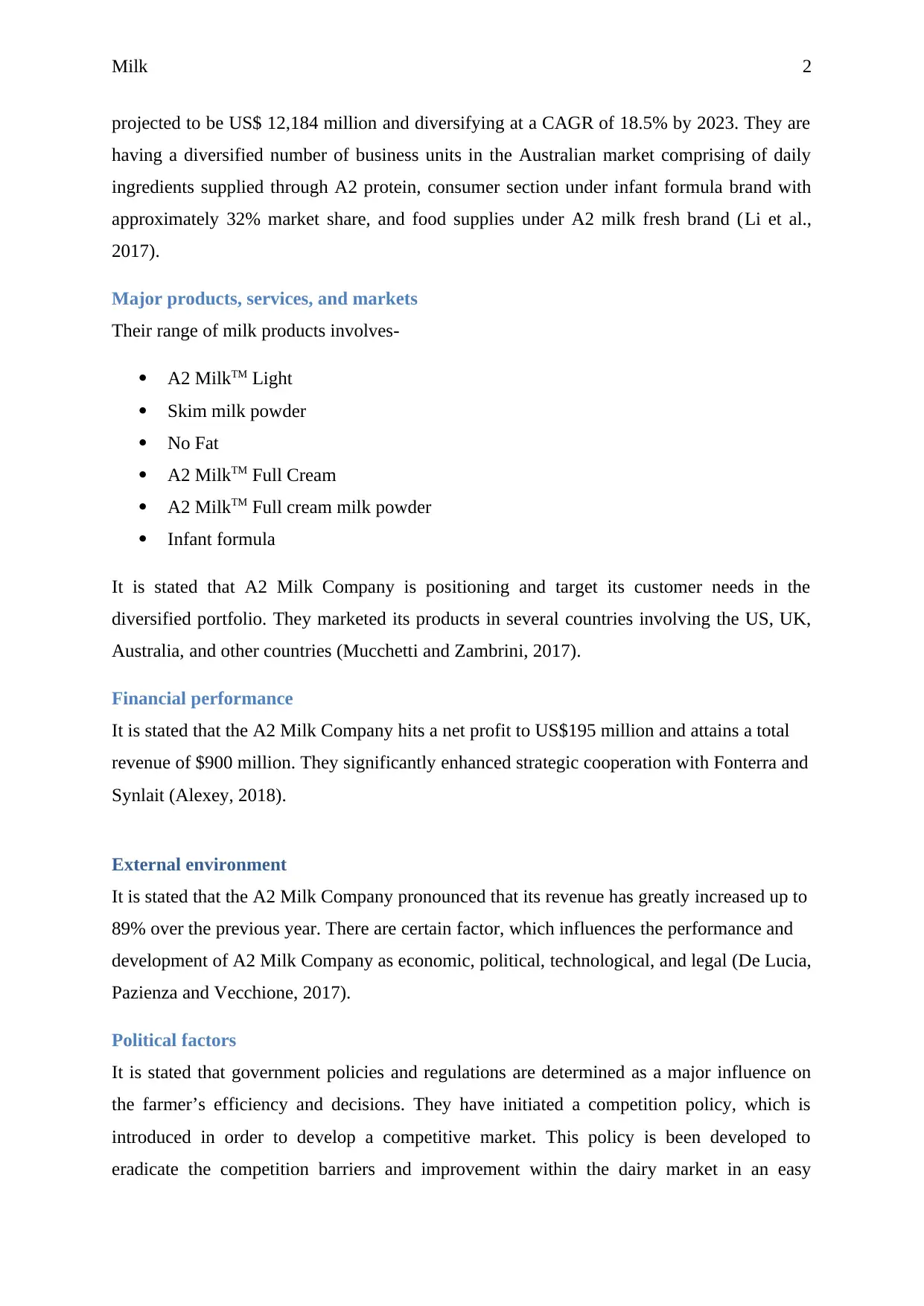
Milk 2
projected to be US$ 12,184 million and diversifying at a CAGR of 18.5% by 2023. They are
having a diversified number of business units in the Australian market comprising of daily
ingredients supplied through A2 protein, consumer section under infant formula brand with
approximately 32% market share, and food supplies under A2 milk fresh brand (Li et al.,
2017).
Major products, services, and markets
Their range of milk products involves-
A2 MilkTM Light
Skim milk powder
No Fat
A2 MilkTM Full Cream
A2 MilkTM Full cream milk powder
Infant formula
It is stated that A2 Milk Company is positioning and target its customer needs in the
diversified portfolio. They marketed its products in several countries involving the US, UK,
Australia, and other countries (Mucchetti and Zambrini, 2017).
Financial performance
It is stated that the A2 Milk Company hits a net profit to US$195 million and attains a total
revenue of $900 million. They significantly enhanced strategic cooperation with Fonterra and
Synlait (Alexey, 2018).
External environment
It is stated that the A2 Milk Company pronounced that its revenue has greatly increased up to
89% over the previous year. There are certain factor, which influences the performance and
development of A2 Milk Company as economic, political, technological, and legal (De Lucia,
Pazienza and Vecchione, 2017).
Political factors
It is stated that government policies and regulations are determined as a major influence on
the farmer’s efficiency and decisions. They have initiated a competition policy, which is
introduced in order to develop a competitive market. This policy is been developed to
eradicate the competition barriers and improvement within the dairy market in an easy
projected to be US$ 12,184 million and diversifying at a CAGR of 18.5% by 2023. They are
having a diversified number of business units in the Australian market comprising of daily
ingredients supplied through A2 protein, consumer section under infant formula brand with
approximately 32% market share, and food supplies under A2 milk fresh brand (Li et al.,
2017).
Major products, services, and markets
Their range of milk products involves-
A2 MilkTM Light
Skim milk powder
No Fat
A2 MilkTM Full Cream
A2 MilkTM Full cream milk powder
Infant formula
It is stated that A2 Milk Company is positioning and target its customer needs in the
diversified portfolio. They marketed its products in several countries involving the US, UK,
Australia, and other countries (Mucchetti and Zambrini, 2017).
Financial performance
It is stated that the A2 Milk Company hits a net profit to US$195 million and attains a total
revenue of $900 million. They significantly enhanced strategic cooperation with Fonterra and
Synlait (Alexey, 2018).
External environment
It is stated that the A2 Milk Company pronounced that its revenue has greatly increased up to
89% over the previous year. There are certain factor, which influences the performance and
development of A2 Milk Company as economic, political, technological, and legal (De Lucia,
Pazienza and Vecchione, 2017).
Political factors
It is stated that government policies and regulations are determined as a major influence on
the farmer’s efficiency and decisions. They have initiated a competition policy, which is
introduced in order to develop a competitive market. This policy is been developed to
eradicate the competition barriers and improvement within the dairy market in an easy
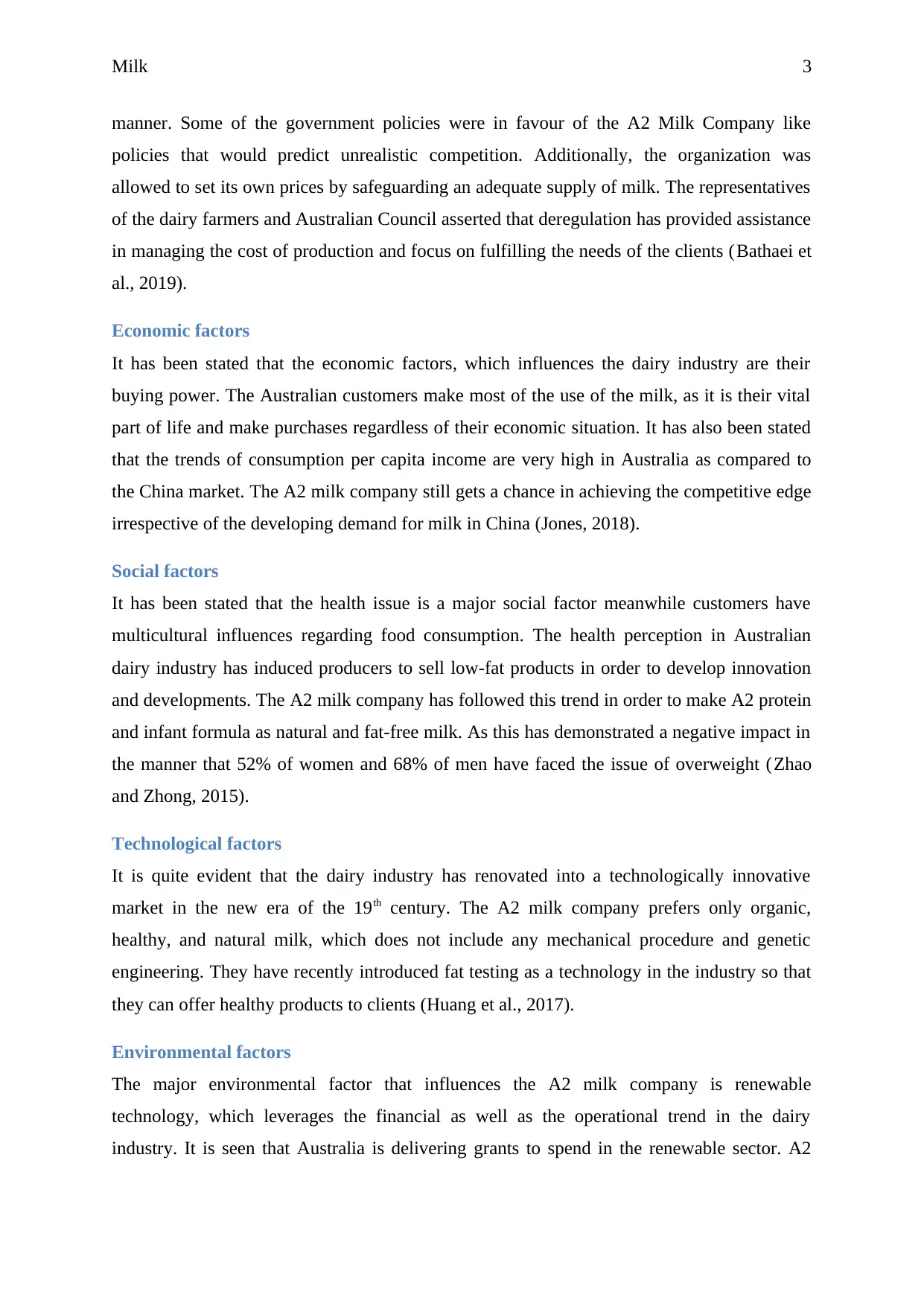
Milk 3
manner. Some of the government policies were in favour of the A2 Milk Company like
policies that would predict unrealistic competition. Additionally, the organization was
allowed to set its own prices by safeguarding an adequate supply of milk. The representatives
of the dairy farmers and Australian Council asserted that deregulation has provided assistance
in managing the cost of production and focus on fulfilling the needs of the clients (Bathaei et
al., 2019).
Economic factors
It has been stated that the economic factors, which influences the dairy industry are their
buying power. The Australian customers make most of the use of the milk, as it is their vital
part of life and make purchases regardless of their economic situation. It has also been stated
that the trends of consumption per capita income are very high in Australia as compared to
the China market. The A2 milk company still gets a chance in achieving the competitive edge
irrespective of the developing demand for milk in China (Jones, 2018).
Social factors
It has been stated that the health issue is a major social factor meanwhile customers have
multicultural influences regarding food consumption. The health perception in Australian
dairy industry has induced producers to sell low-fat products in order to develop innovation
and developments. The A2 milk company has followed this trend in order to make A2 protein
and infant formula as natural and fat-free milk. As this has demonstrated a negative impact in
the manner that 52% of women and 68% of men have faced the issue of overweight (Zhao
and Zhong, 2015).
Technological factors
It is quite evident that the dairy industry has renovated into a technologically innovative
market in the new era of the 19th century. The A2 milk company prefers only organic,
healthy, and natural milk, which does not include any mechanical procedure and genetic
engineering. They have recently introduced fat testing as a technology in the industry so that
they can offer healthy products to clients (Huang et al., 2017).
Environmental factors
The major environmental factor that influences the A2 milk company is renewable
technology, which leverages the financial as well as the operational trend in the dairy
industry. It is seen that Australia is delivering grants to spend in the renewable sector. A2
manner. Some of the government policies were in favour of the A2 Milk Company like
policies that would predict unrealistic competition. Additionally, the organization was
allowed to set its own prices by safeguarding an adequate supply of milk. The representatives
of the dairy farmers and Australian Council asserted that deregulation has provided assistance
in managing the cost of production and focus on fulfilling the needs of the clients (Bathaei et
al., 2019).
Economic factors
It has been stated that the economic factors, which influences the dairy industry are their
buying power. The Australian customers make most of the use of the milk, as it is their vital
part of life and make purchases regardless of their economic situation. It has also been stated
that the trends of consumption per capita income are very high in Australia as compared to
the China market. The A2 milk company still gets a chance in achieving the competitive edge
irrespective of the developing demand for milk in China (Jones, 2018).
Social factors
It has been stated that the health issue is a major social factor meanwhile customers have
multicultural influences regarding food consumption. The health perception in Australian
dairy industry has induced producers to sell low-fat products in order to develop innovation
and developments. The A2 milk company has followed this trend in order to make A2 protein
and infant formula as natural and fat-free milk. As this has demonstrated a negative impact in
the manner that 52% of women and 68% of men have faced the issue of overweight (Zhao
and Zhong, 2015).
Technological factors
It is quite evident that the dairy industry has renovated into a technologically innovative
market in the new era of the 19th century. The A2 milk company prefers only organic,
healthy, and natural milk, which does not include any mechanical procedure and genetic
engineering. They have recently introduced fat testing as a technology in the industry so that
they can offer healthy products to clients (Huang et al., 2017).
Environmental factors
The major environmental factor that influences the A2 milk company is renewable
technology, which leverages the financial as well as the operational trend in the dairy
industry. It is seen that Australia is delivering grants to spend in the renewable sector. A2
Secure Best Marks with AI Grader
Need help grading? Try our AI Grader for instant feedback on your assignments.
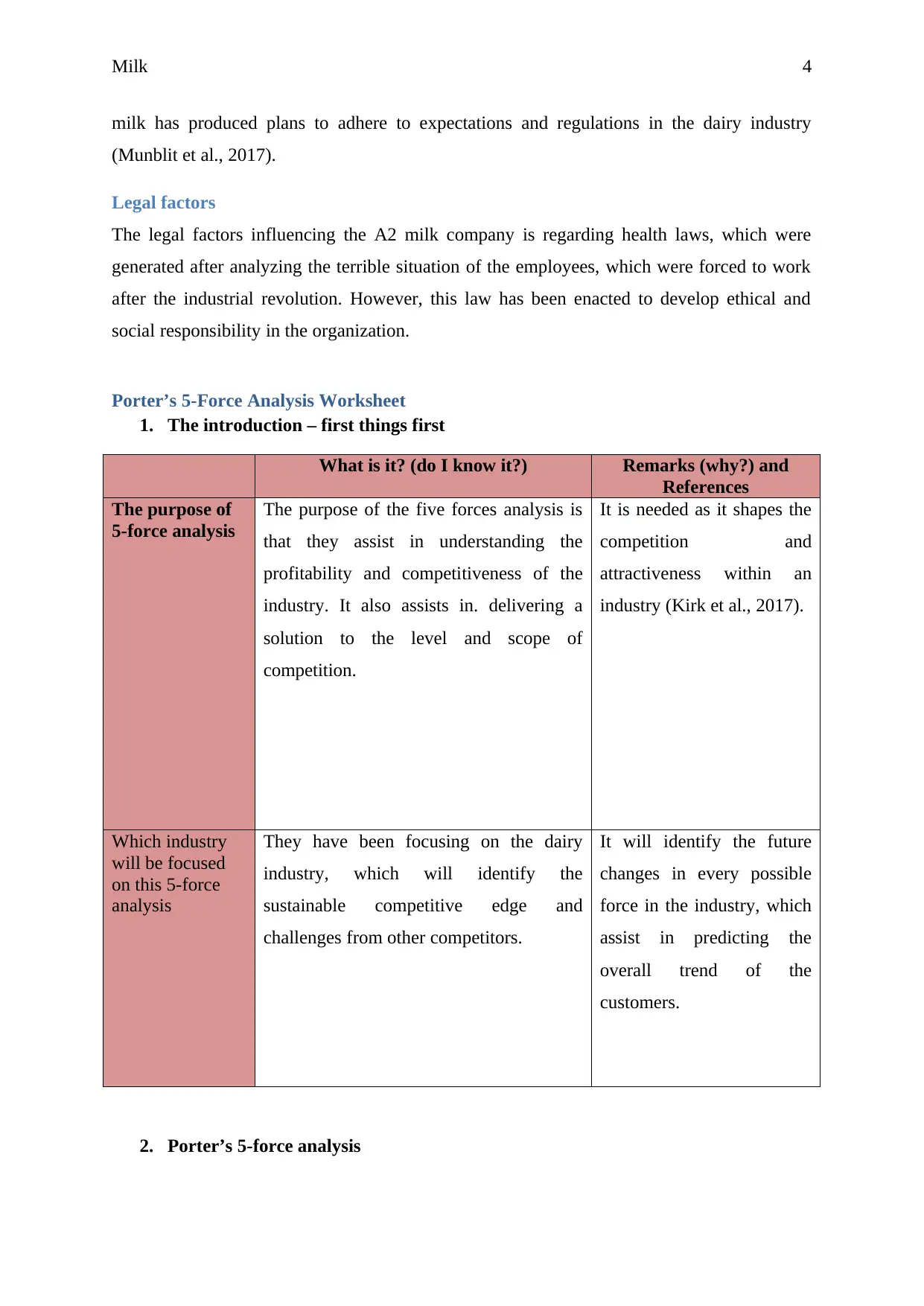
Milk 4
milk has produced plans to adhere to expectations and regulations in the dairy industry
(Munblit et al., 2017).
Legal factors
The legal factors influencing the A2 milk company is regarding health laws, which were
generated after analyzing the terrible situation of the employees, which were forced to work
after the industrial revolution. However, this law has been enacted to develop ethical and
social responsibility in the organization.
Porter’s 5-Force Analysis Worksheet
1. The introduction – first things first
What is it? (do I know it?) Remarks (why?) and
References
The purpose of
5-force analysis
The purpose of the five forces analysis is
that they assist in understanding the
profitability and competitiveness of the
industry. It also assists in. delivering a
solution to the level and scope of
competition.
It is needed as it shapes the
competition and
attractiveness within an
industry (Kirk et al., 2017).
Which industry
will be focused
on this 5-force
analysis
They have been focusing on the dairy
industry, which will identify the
sustainable competitive edge and
challenges from other competitors.
It will identify the future
changes in every possible
force in the industry, which
assist in predicting the
overall trend of the
customers.
2. Porter’s 5-force analysis
milk has produced plans to adhere to expectations and regulations in the dairy industry
(Munblit et al., 2017).
Legal factors
The legal factors influencing the A2 milk company is regarding health laws, which were
generated after analyzing the terrible situation of the employees, which were forced to work
after the industrial revolution. However, this law has been enacted to develop ethical and
social responsibility in the organization.
Porter’s 5-Force Analysis Worksheet
1. The introduction – first things first
What is it? (do I know it?) Remarks (why?) and
References
The purpose of
5-force analysis
The purpose of the five forces analysis is
that they assist in understanding the
profitability and competitiveness of the
industry. It also assists in. delivering a
solution to the level and scope of
competition.
It is needed as it shapes the
competition and
attractiveness within an
industry (Kirk et al., 2017).
Which industry
will be focused
on this 5-force
analysis
They have been focusing on the dairy
industry, which will identify the
sustainable competitive edge and
challenges from other competitors.
It will identify the future
changes in every possible
force in the industry, which
assist in predicting the
overall trend of the
customers.
2. Porter’s 5-force analysis
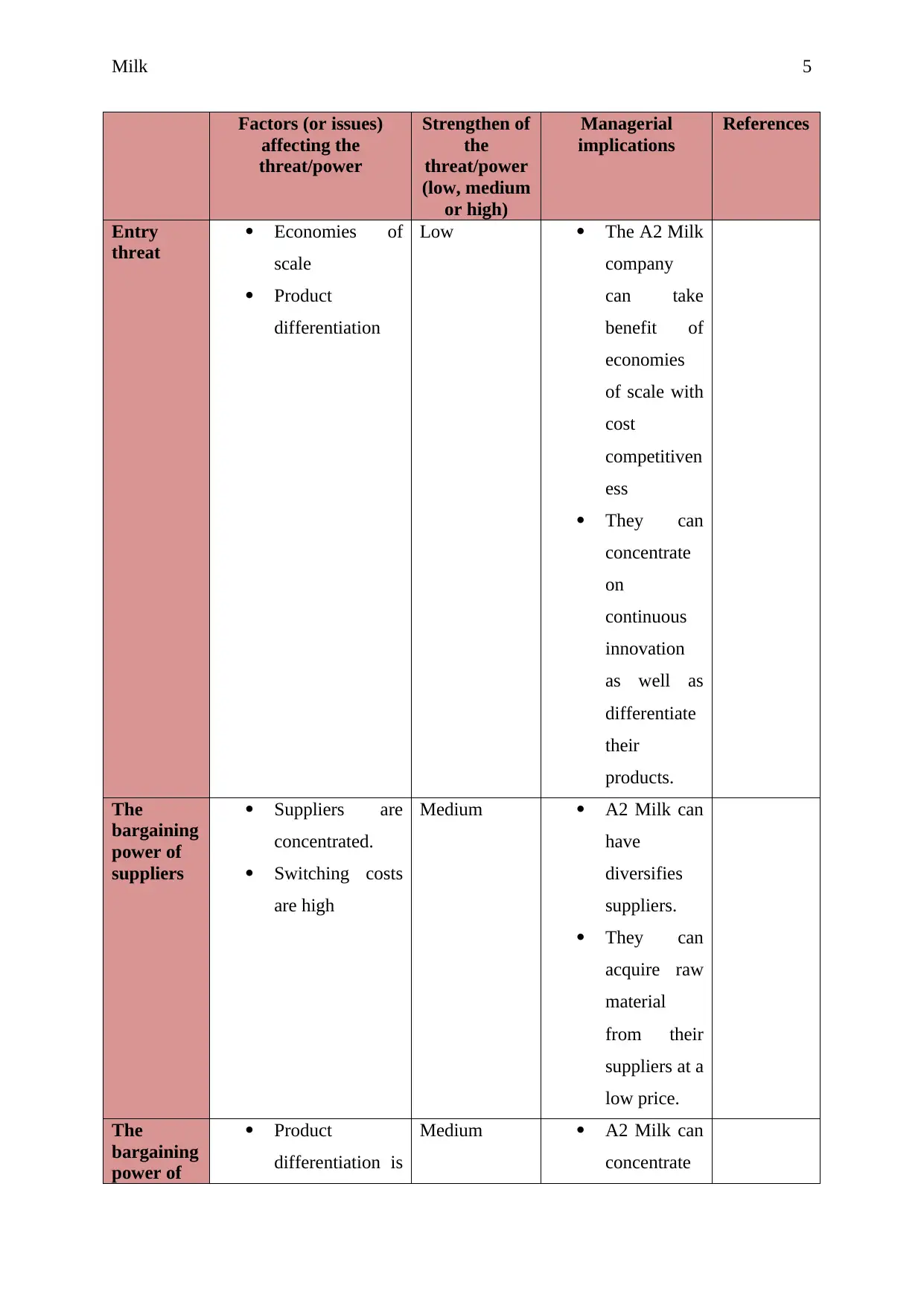
Milk 5
Factors (or issues)
affecting the
threat/power
Strengthen of
the
threat/power
(low, medium
or high)
Managerial
implications
References
Entry
threat
Economies of
scale
Product
differentiation
Low The A2 Milk
company
can take
benefit of
economies
of scale with
cost
competitiven
ess
They can
concentrate
on
continuous
innovation
as well as
differentiate
their
products.
The
bargaining
power of
suppliers
Suppliers are
concentrated.
Switching costs
are high
Medium A2 Milk can
have
diversifies
suppliers.
They can
acquire raw
material
from their
suppliers at a
low price.
The
bargaining
power of
Product
differentiation is
Medium A2 Milk can
concentrate
Factors (or issues)
affecting the
threat/power
Strengthen of
the
threat/power
(low, medium
or high)
Managerial
implications
References
Entry
threat
Economies of
scale
Product
differentiation
Low The A2 Milk
company
can take
benefit of
economies
of scale with
cost
competitiven
ess
They can
concentrate
on
continuous
innovation
as well as
differentiate
their
products.
The
bargaining
power of
suppliers
Suppliers are
concentrated.
Switching costs
are high
Medium A2 Milk can
have
diversifies
suppliers.
They can
acquire raw
material
from their
suppliers at a
low price.
The
bargaining
power of
Product
differentiation is
Medium A2 Milk can
concentrate
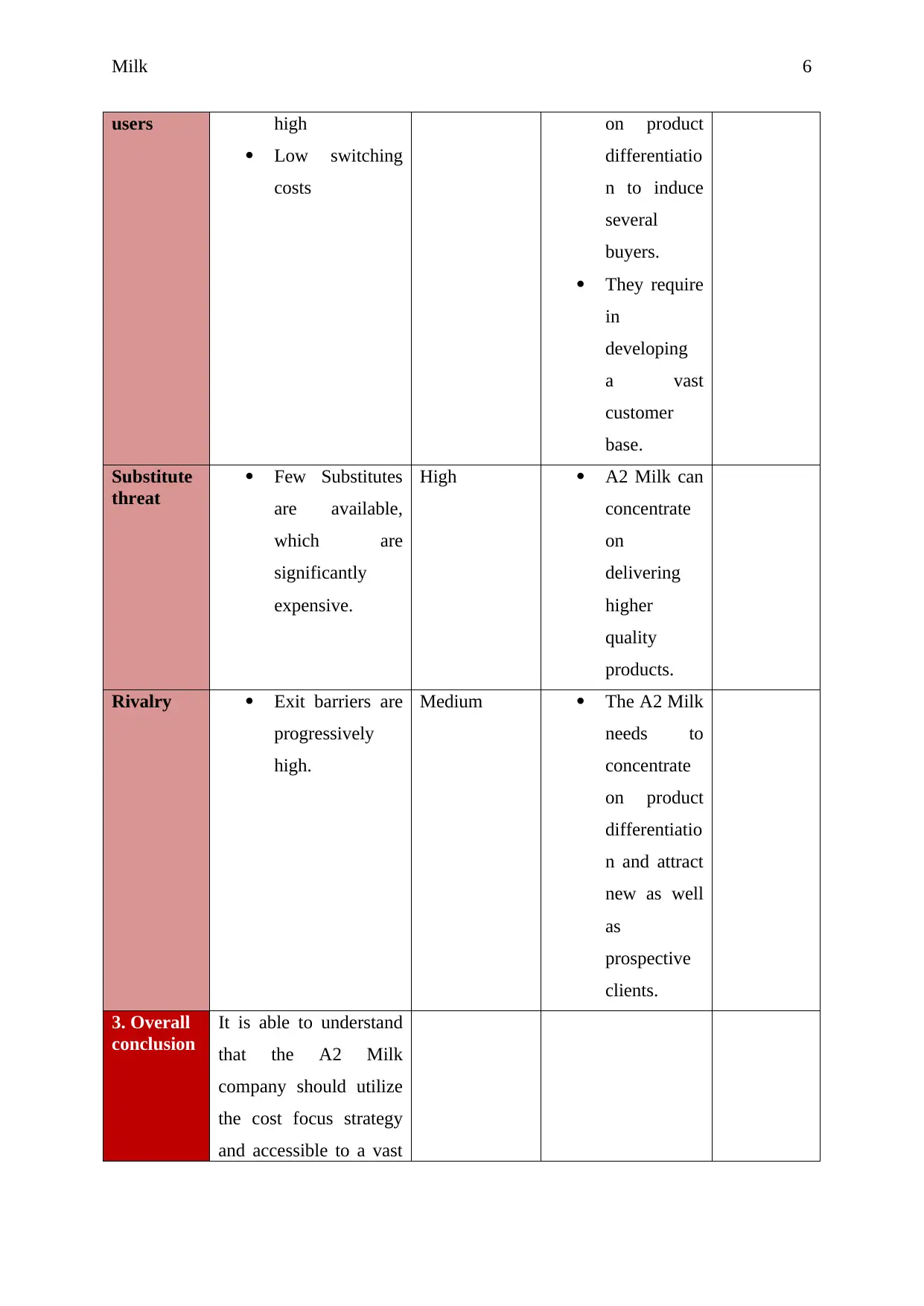
Milk 6
users high
Low switching
costs
on product
differentiatio
n to induce
several
buyers.
They require
in
developing
a vast
customer
base.
Substitute
threat
Few Substitutes
are available,
which are
significantly
expensive.
High A2 Milk can
concentrate
on
delivering
higher
quality
products.
Rivalry Exit barriers are
progressively
high.
Medium The A2 Milk
needs to
concentrate
on product
differentiatio
n and attract
new as well
as
prospective
clients.
3. Overall
conclusion
It is able to understand
that the A2 Milk
company should utilize
the cost focus strategy
and accessible to a vast
users high
Low switching
costs
on product
differentiatio
n to induce
several
buyers.
They require
in
developing
a vast
customer
base.
Substitute
threat
Few Substitutes
are available,
which are
significantly
expensive.
High A2 Milk can
concentrate
on
delivering
higher
quality
products.
Rivalry Exit barriers are
progressively
high.
Medium The A2 Milk
needs to
concentrate
on product
differentiatio
n and attract
new as well
as
prospective
clients.
3. Overall
conclusion
It is able to understand
that the A2 Milk
company should utilize
the cost focus strategy
and accessible to a vast
Paraphrase This Document
Need a fresh take? Get an instant paraphrase of this document with our AI Paraphraser

Milk 7
number of customers.
(Moreno-Izquierdo, Ramón-Rodríguez and Perles-Ribes, 2016)
Radar diagram
Entry threat
The bargaining power of suppliers
The bargaining power of users
Substitute threat
Rivalry
0
0.5
1
A2 Milk Company
Factors (or issues) affecting the threat/power
Strengthen of the threat/power (low, medium or high)
Managerial implications
Conclusion
In conclusion, it has been stated that the A2 milk company advertised its protein free and
other associated products in Australia. There has been a major connection with the external
environmental factors as it influences the regulatory framework and another system of the
organization. It might affect the strength of the five forces analysis by enhancing their
competitive situation in the market. It empowers financial experts to identify and make
appropriate decisions. However, the manager of the organization who utilizes external
environment analysis might concentrate on social factors of customer behaviour. It is stated
that the dairy industry is profitable for the industry in the future as it offers natural products at
premium quality. It assists in examining the forces, which can deal with entry barriers
effectively.
number of customers.
(Moreno-Izquierdo, Ramón-Rodríguez and Perles-Ribes, 2016)
Radar diagram
Entry threat
The bargaining power of suppliers
The bargaining power of users
Substitute threat
Rivalry
0
0.5
1
A2 Milk Company
Factors (or issues) affecting the threat/power
Strengthen of the threat/power (low, medium or high)
Managerial implications
Conclusion
In conclusion, it has been stated that the A2 milk company advertised its protein free and
other associated products in Australia. There has been a major connection with the external
environmental factors as it influences the regulatory framework and another system of the
organization. It might affect the strength of the five forces analysis by enhancing their
competitive situation in the market. It empowers financial experts to identify and make
appropriate decisions. However, the manager of the organization who utilizes external
environment analysis might concentrate on social factors of customer behaviour. It is stated
that the dairy industry is profitable for the industry in the future as it offers natural products at
premium quality. It assists in examining the forces, which can deal with entry barriers
effectively.
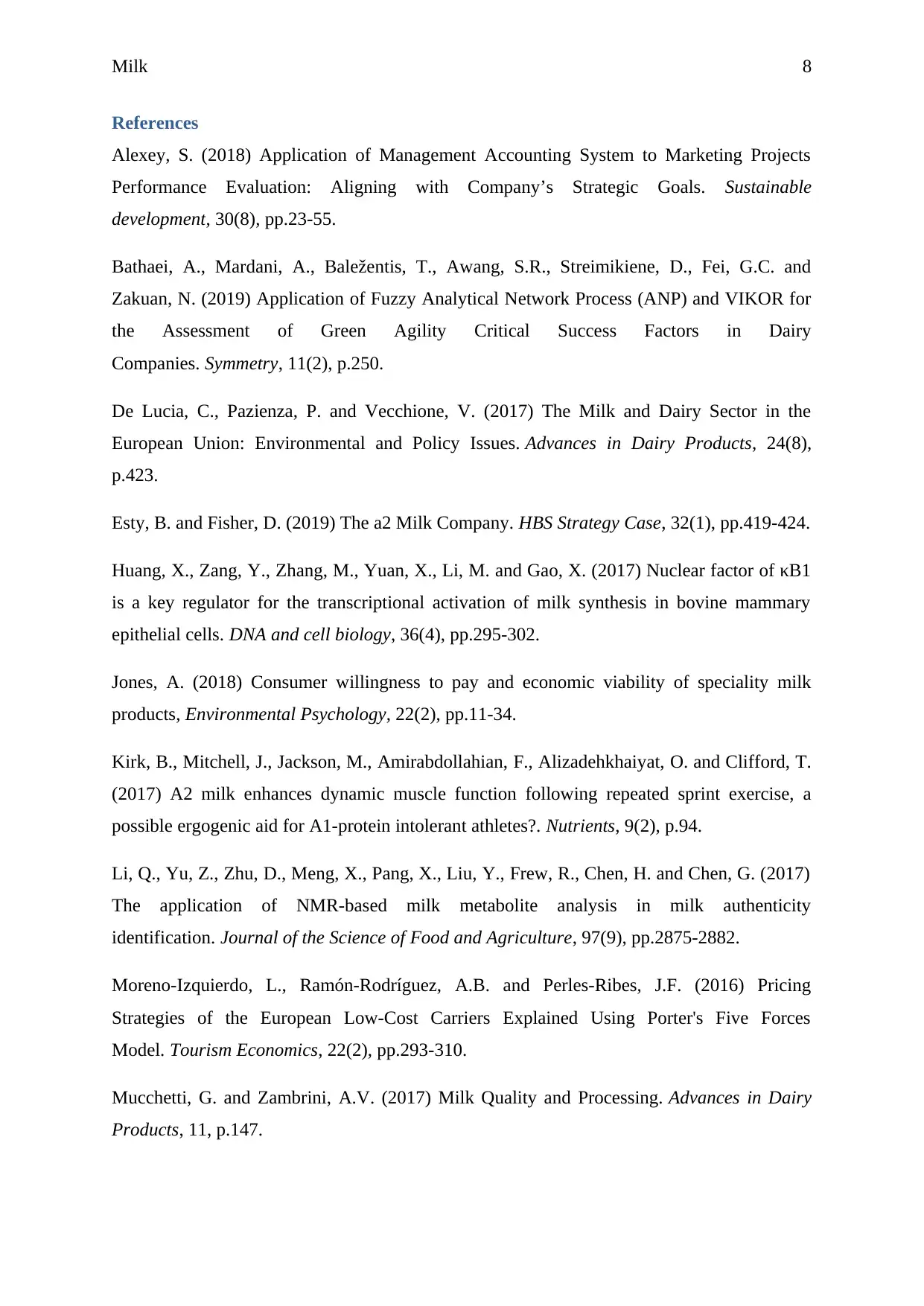
Milk 8
References
Alexey, S. (2018) Application of Management Accounting System to Marketing Projects
Performance Evaluation: Aligning with Company’s Strategic Goals. Sustainable
development, 30(8), pp.23-55.
Bathaei, A., Mardani, A., Baležentis, T., Awang, S.R., Streimikiene, D., Fei, G.C. and
Zakuan, N. (2019) Application of Fuzzy Analytical Network Process (ANP) and VIKOR for
the Assessment of Green Agility Critical Success Factors in Dairy
Companies. Symmetry, 11(2), p.250.
De Lucia, C., Pazienza, P. and Vecchione, V. (2017) The Milk and Dairy Sector in the
European Union: Environmental and Policy Issues. Advances in Dairy Products, 24(8),
p.423.
Esty, B. and Fisher, D. (2019) The a2 Milk Company. HBS Strategy Case, 32(1), pp.419-424.
Huang, X., Zang, Y., Zhang, M., Yuan, X., Li, M. and Gao, X. (2017) Nuclear factor of κB1
is a key regulator for the transcriptional activation of milk synthesis in bovine mammary
epithelial cells. DNA and cell biology, 36(4), pp.295-302.
Jones, A. (2018) Consumer willingness to pay and economic viability of speciality milk
products, Environmental Psychology, 22(2), pp.11-34.
Kirk, B., Mitchell, J., Jackson, M., Amirabdollahian, F., Alizadehkhaiyat, O. and Clifford, T.
(2017) A2 milk enhances dynamic muscle function following repeated sprint exercise, a
possible ergogenic aid for A1-protein intolerant athletes?. Nutrients, 9(2), p.94.
Li, Q., Yu, Z., Zhu, D., Meng, X., Pang, X., Liu, Y., Frew, R., Chen, H. and Chen, G. (2017)
The application of NMR‐based milk metabolite analysis in milk authenticity
identification. Journal of the Science of Food and Agriculture, 97(9), pp.2875-2882.
Moreno-Izquierdo, L., Ramón-Rodríguez, A.B. and Perles-Ribes, J.F. (2016) Pricing
Strategies of the European Low-Cost Carriers Explained Using Porter's Five Forces
Model. Tourism Economics, 22(2), pp.293-310.
Mucchetti, G. and Zambrini, A.V. (2017) Milk Quality and Processing. Advances in Dairy
Products, 11, p.147.
References
Alexey, S. (2018) Application of Management Accounting System to Marketing Projects
Performance Evaluation: Aligning with Company’s Strategic Goals. Sustainable
development, 30(8), pp.23-55.
Bathaei, A., Mardani, A., Baležentis, T., Awang, S.R., Streimikiene, D., Fei, G.C. and
Zakuan, N. (2019) Application of Fuzzy Analytical Network Process (ANP) and VIKOR for
the Assessment of Green Agility Critical Success Factors in Dairy
Companies. Symmetry, 11(2), p.250.
De Lucia, C., Pazienza, P. and Vecchione, V. (2017) The Milk and Dairy Sector in the
European Union: Environmental and Policy Issues. Advances in Dairy Products, 24(8),
p.423.
Esty, B. and Fisher, D. (2019) The a2 Milk Company. HBS Strategy Case, 32(1), pp.419-424.
Huang, X., Zang, Y., Zhang, M., Yuan, X., Li, M. and Gao, X. (2017) Nuclear factor of κB1
is a key regulator for the transcriptional activation of milk synthesis in bovine mammary
epithelial cells. DNA and cell biology, 36(4), pp.295-302.
Jones, A. (2018) Consumer willingness to pay and economic viability of speciality milk
products, Environmental Psychology, 22(2), pp.11-34.
Kirk, B., Mitchell, J., Jackson, M., Amirabdollahian, F., Alizadehkhaiyat, O. and Clifford, T.
(2017) A2 milk enhances dynamic muscle function following repeated sprint exercise, a
possible ergogenic aid for A1-protein intolerant athletes?. Nutrients, 9(2), p.94.
Li, Q., Yu, Z., Zhu, D., Meng, X., Pang, X., Liu, Y., Frew, R., Chen, H. and Chen, G. (2017)
The application of NMR‐based milk metabolite analysis in milk authenticity
identification. Journal of the Science of Food and Agriculture, 97(9), pp.2875-2882.
Moreno-Izquierdo, L., Ramón-Rodríguez, A.B. and Perles-Ribes, J.F. (2016) Pricing
Strategies of the European Low-Cost Carriers Explained Using Porter's Five Forces
Model. Tourism Economics, 22(2), pp.293-310.
Mucchetti, G. and Zambrini, A.V. (2017) Milk Quality and Processing. Advances in Dairy
Products, 11, p.147.
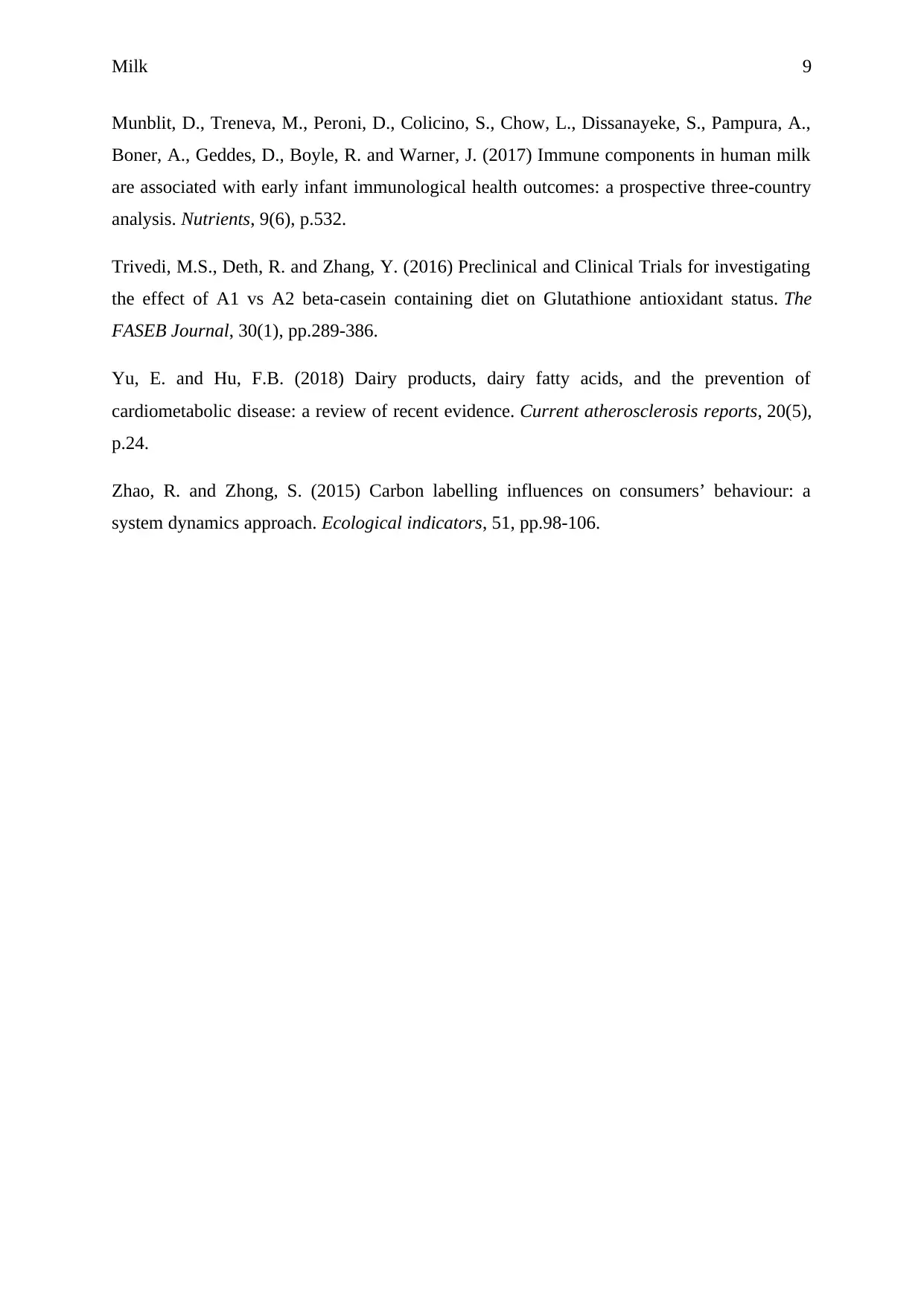
Milk 9
Munblit, D., Treneva, M., Peroni, D., Colicino, S., Chow, L., Dissanayeke, S., Pampura, A.,
Boner, A., Geddes, D., Boyle, R. and Warner, J. (2017) Immune components in human milk
are associated with early infant immunological health outcomes: a prospective three-country
analysis. Nutrients, 9(6), p.532.
Trivedi, M.S., Deth, R. and Zhang, Y. (2016) Preclinical and Clinical Trials for investigating
the effect of A1 vs A2 beta-casein containing diet on Glutathione antioxidant status. The
FASEB Journal, 30(1), pp.289-386.
Yu, E. and Hu, F.B. (2018) Dairy products, dairy fatty acids, and the prevention of
cardiometabolic disease: a review of recent evidence. Current atherosclerosis reports, 20(5),
p.24.
Zhao, R. and Zhong, S. (2015) Carbon labelling influences on consumers’ behaviour: a
system dynamics approach. Ecological indicators, 51, pp.98-106.
Munblit, D., Treneva, M., Peroni, D., Colicino, S., Chow, L., Dissanayeke, S., Pampura, A.,
Boner, A., Geddes, D., Boyle, R. and Warner, J. (2017) Immune components in human milk
are associated with early infant immunological health outcomes: a prospective three-country
analysis. Nutrients, 9(6), p.532.
Trivedi, M.S., Deth, R. and Zhang, Y. (2016) Preclinical and Clinical Trials for investigating
the effect of A1 vs A2 beta-casein containing diet on Glutathione antioxidant status. The
FASEB Journal, 30(1), pp.289-386.
Yu, E. and Hu, F.B. (2018) Dairy products, dairy fatty acids, and the prevention of
cardiometabolic disease: a review of recent evidence. Current atherosclerosis reports, 20(5),
p.24.
Zhao, R. and Zhong, S. (2015) Carbon labelling influences on consumers’ behaviour: a
system dynamics approach. Ecological indicators, 51, pp.98-106.
1 out of 10
Related Documents
Your All-in-One AI-Powered Toolkit for Academic Success.
+13062052269
info@desklib.com
Available 24*7 on WhatsApp / Email
![[object Object]](/_next/static/media/star-bottom.7253800d.svg)
Unlock your academic potential
© 2024 | Zucol Services PVT LTD | All rights reserved.





